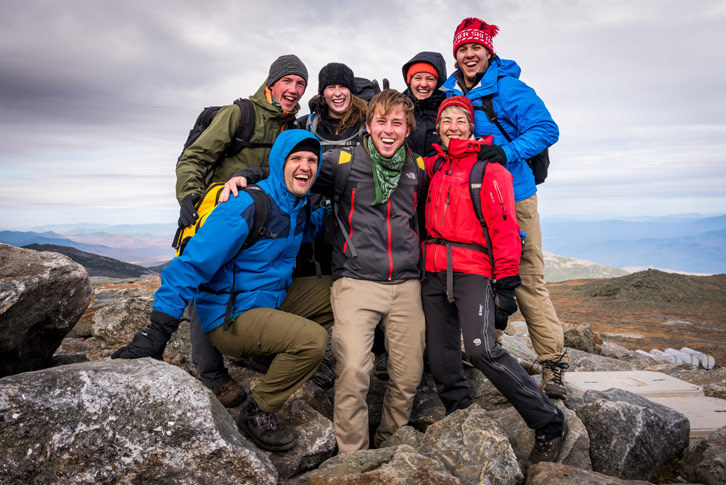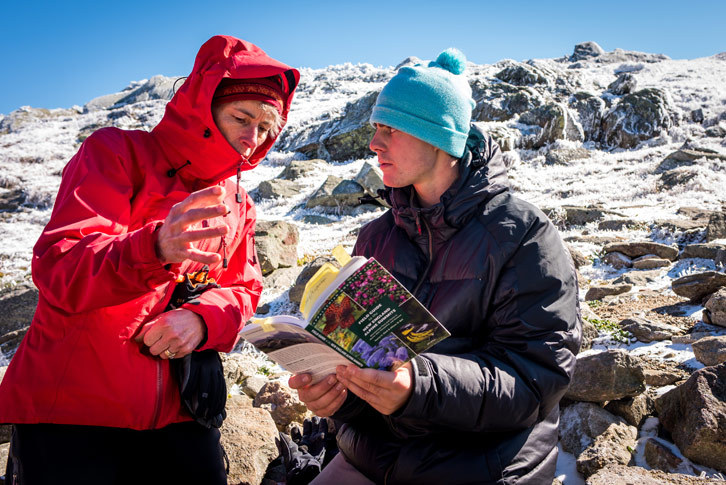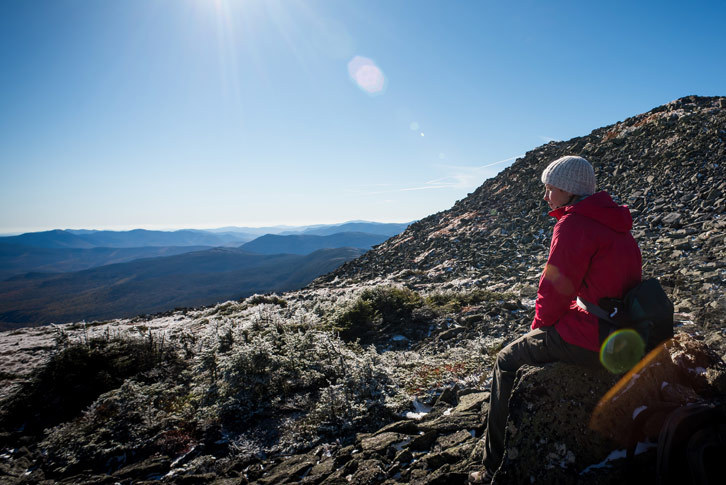On a warm and bright October morning, 12 Colby-Sawyer students and two professors prepared to set off for a four-day journey into the high peaks of the Presidential Range in the White Mountains National Forest. Dressed in layers, they strapped on backpacks stuffed with sleeping bags, warm jackets, food and other supplies and hit the Tuckerman's Ravine Trail for an ascent into the alpine zone.
The students—mostly junior and senior biology, environmental studies and environmental science majors—were part of Associate Professor of Natural Sciences Laura Alexander's Alpine Flora Communities course. In the previous month they had learned about the fragile ecosystems that inhabit high-altitude alpine regions, where plants are buffeted by high winds, heavy snow and extreme cold. Field guides close at hand, the students were anxious to find and identify these plant communities in the wild and experience the environment to which these species have adapted.

The course includes a few day hikes and this longer expedition marked the addition of a new Alpine Communities Field Studies Program. It is the fourth field study program to be added to the curriculum, after Desert Communities (in Arizona), Marine Communities (on Martha's Vineyard) and River Communities (in the Colorado River Basin).
The hike began at about a 2,000-foot elevation and quickly turned rocky and steep. Professor Alexander kept the group focused by making frequent stops to point out plant communities along the trail and reminded students to keep an eye on how species appeared and disappeared with changes in elevation. She prodded them with questions: When did the hardwood forest transition to a spruce fir forest? Which plant communities should we be seeing now? What are the major impacts on the flora in this area?
The next day, the group climbed up Tuckerman's Ravine on the way to Lakes in the Clouds and Mt. Monroe. The trail grew narrower and more arduous, but the views were stunning. When the group took a break, Harvey Pine, assistant professor of Natural Sciences, explained the geological origins of the amphitheater that surrounded them. Like an impassioned preacher, he raised his arms and voice as he described how hundreds of millions of years ago a vast alpine glacier began to cut into the metamorphic rock that eventually carved the ravine that is now a popular, though dangerous, place to ski.

In the Zone
As they reached the high elevations of the alpine zone, students began to see some more familiar plant communities growing along the trail, between rocks and behind boulders. They pulled out their field guides and huddled around the plants to try to pinpoint the species, the beginning of a friendly “name the species” competition.
As the group reached the top of the ravine, they were pummeled by cold winds whipping across the alpine garden that stretched out before them. The students pulled on their wind jackets and walked through the garden in awe of the beauty and resilience of the flora around them.
A small sign that read “A Tough Place to Grow” reminded the hikers of the flora's fragility and to stay on the trail. Professor Alexander noted that one-quarter of the U.S. population lives within a day's drive of the White Mountains and it's extremely important for students to recognize the negative impacts that humans can have on the flora.

“These plants are like little heroes—they hang on no matter what—but by stepping on them, hikers loosen their roots and they just blow away,” she said. “I want students to get that message to stay on the trail and take the knowledge they learned in New Hampshire's White Mountains to other environments. That's the framework for many of our courses: Let's go in and understand a place, what grows here and what the impacts are on these plant communities, and let's educate people and protect these environments.”
After some long days of hiking, the students were excited to talk about their latest adventures in learning. Adam Wilson had participated in the River Communities trip in the spring and said field experiences provide the “best classroom.” “There's really nothing like it—the learning environment is just incredible,” he said. “I may be biased, but I think the best way to learn is to actually live it. You can't really learn from a book in the same way.”
Fellow Environmental Studies major Laurel Bauer also took part in the River Communities course, but she found this trip to the alpine zone “really special.” “It's definitely a course that can't be taught just inside the classroom. You need to be out doing the work and seeing, feeling, smelling and touching,” she explained.
By journey's end, the students knew that not only is the alpine zone a tough place to grow, it is a great place to learn.
